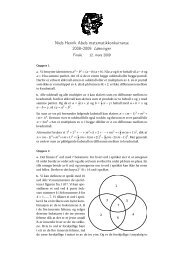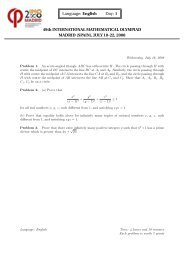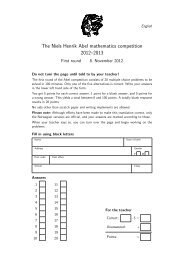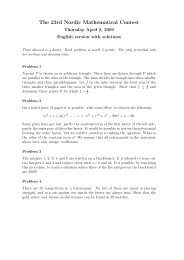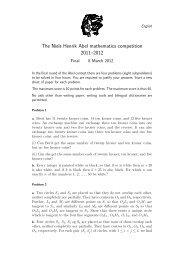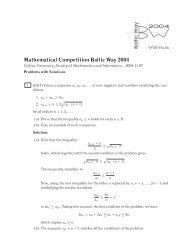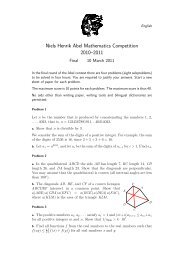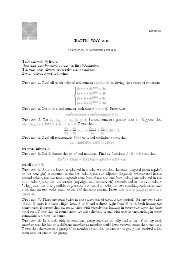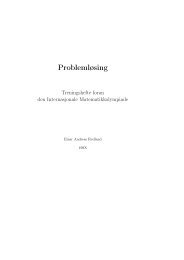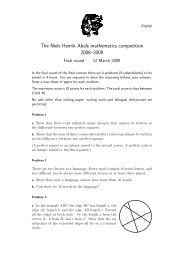Solutions - Georg Mohr-Konkurrencen
Solutions - Georg Mohr-Konkurrencen
Solutions - Georg Mohr-Konkurrencen
- No tags were found...
You also want an ePaper? Increase the reach of your titles
YUMPU automatically turns print PDFs into web optimized ePapers that Google loves.
Baltic Way 2001Hamburg, November 4, 2001Problems1. A set of 8 problems was prepared for an examination. Each student wasgiven 3 of them. No two students received more than one common problem.What is the largest possible number of students?2. Let n 2 be a positive integer. Find whether there exist n pairwisenonintersecting nonempty subsets of {1, 2, 3, . . .} such that each positiveinteger can be expressed in a unique way as a sum of at most n integers,all from different subsets.3. The numbers 1, 2, . . . , 49 are placed in a 7 × 7 array, and the sum of thenumbers in each row and in each column is computed. Some of these 14sums are odd while others are even. Let A denote the sum of all the oddsums and B the sum of all even sums. Is it possible that the numbers wereplaced in the array in such a way that A = B ?4. Let p and q be two different primes. Prove that⌊ pq⌋+⌊ 2p⌋+q⌊ 3p⌋+ . . . +q⌊ (q − 1)p⌋q= 1 (p − 1)(q − 1) .2(Here ⌊x⌋ denotes the largest integer not greater than x.)5. Let 2001 given points on a circle be colored either red or green. In onestep all points are recolored simultaneously in the following way: If bothdirect neighbors of a point P have the same color as P , then the color of Premains unchanged, otherwise P obtains the other color. Starting with thefirst coloring F 1 , we obtain the colorings F 2 , F 3 , . . . after several recoloringsteps. Prove that there is a number n 0 1000 such that F n0 = F n0+2 . Isthe assertion also true if 1000 is replaced by 999?6. The points A, B , C , D , E lie on the circle c in this order and satisfyAB ‖ EC and AC ‖ ED . The line tangent to the circle c at E meets theline AB at P . The lines BD and EC meet at Q. Prove that |AC| = |P Q|.1
7. Given a parallelogram ABCD . A circle passing through A meets the linesegments AB , AC and AD at inner points M , K , N , respectively. Provethat|AB| · |AM| + |AD| · |AN| = |AK| · |AC| .8. Let ABCD be a convex quadrilateral, and let N be the midpoint of BC .Suppose further that ̸ AND = 135 ◦ . Prove that|AB| + |CD| + 1 √2 · |BC| |AD| .9. Given a rhombus ABCD , find the locus of the points P lying inside therhombus and satisfying ̸ AP D + ̸ BP C = 180 ◦ .10. In a triangle ABC , the bisector of ̸ BAC meets the side BC at the pointD . Knowing that |BD| · |CD| = |AD| 2 and ̸ ADB = 45 ◦ , determine theangles of triangle ABC .11. The real-valued function f is defined for all positive integers. For anyintegers a > 1, b > 1 with d = gcd(a, b), we have( ( a) ( b) )f(ab) = f(d) · f + f ,d dDetermine all possible values of f(2001).12. Let a 1 , a 2 , . . . , a n be positive real numbers such thatn∑n∑a 5 i = 5. Prove that a i > 3 2 .i=1i=1n∑i=1a 3 i= 3 and13. Let a 0 , a 1 , a 2 , . . . be a sequence of real numbers satisfying a 0 = 1 anda n = a ⌊7n/9⌋ + a ⌊n/9⌋ for n = 1, 2, . . .. Prove that there exists a positiveinteger k with a k
the cards can be divided into two heaps with sums s 1 and s 2 so thatnn + 1 s 1 1.s 215. Let a 0 , a 1 , a 2 , . . . be a sequence of positive real numbers satisfyingi · a 2 i (i + 1) · a i−1 a i+1 for i = 1, 2, . . .. Furthermore, let x and ybe positive reals, and let b i = xa i + ya i−1 for i = 1, 2, . . .. Prove that theinequality i · b 2 i > (i+1) · b i−1 b i+1 holds for all integers i 2.16. Let f be a real-valued function defined on the positive integers satisfyingthe following condition: For all n > 1 there exists a prime divisor p of nsuch that( n)f(n) = f − f(p) .pGiven that f(2001) = 1, what is the value of f(2002)?17. Let n be a positive integer. Prove that at least 2 n−1 + n numbers can bechosen from the set {1, 2, 3, . . . , 2 n } such that for any two different chosennumbers x and y , x + y is not a divisor of x · y .18. Let a be an odd integer. Prove that a 2n + 2 2n and a 2m + 2 2m are relativelyprime for all positive integers n and m with n ≠ m.19. What is the smallest positive odd integer having the same number of positivedivisors as 360?20. From a sequence of integers (a, b, c, d) each of the sequences(c, d, a, b), (b, a, d, c), (a+nc, b+nd, c, d), (a+nb, b, c+nd, d) ,for arbitrary integer n can be obtained by one step. Is it possible to obtain(3, 4, 5, 7) from (1, 2, 3, 4) through a sequence of such steps?<strong>Solutions</strong>1. Answer: 8.Denote the problems by A, B , C , D , E , F , G, H , then 8 possibleproblem sets are ABC , ADE , AF G, BDG, BF H , CDH , CEF , EGH .Hence, there could be 8 students.3
Suppose that some problem (e.g., A) was given to 4 students. Then eachof these 4 students should receive 2 different “supplementary” problems,and there should be at least 9 problems — a contradiction. Therefore eachproblem was given to at most 3 students, and there were at most 8 · 3 = 24“awardings” of problems. As each student was “awarded” 3 problems, therewere at most 8 students.2. Answer: yes.Let A 1 be the set of positive integers whose only non-zero digits may bethe 1-st, the (n + 1)-st, the (2n + 1)-st etc. from the end; A 2 be the set ofpositive integers whose only non-zero digits may be the 2-nd, the (n + 2)-nd, the (2n + 2)-nd etc. from the end, and so on. The sets A 1 , A 2 , . . . , A nhave the required property.Remark. This problem is quite similar to problem 18 from Baltic Way 1997.3. Answer: no.If this were possible, then 2 · (1 + . . . + 49) = A + B = 2B . But B is evensince it is the sum of even numbers, whereas 1 + . . . + 49 = 25 · 49 is odd.This is a contradiction.4. The line y = p x contains the diagonal of the rectangle with vertices (0, 0),q(q, 0), (q, p) and (0, p) and passes through no points with integer coordinatesin the interior of that rectangle. For k = 1, 2, . . . , q−1 the summand⌊ kp⌋counts the number of interior points of the rectangle lying below theqdiagonal y = p x and having x-coordinate equal to k . Therefore the sumqin consideration counts all interior points with integer coordinates belowthe diagonal, which is exactly half the number of all points with integer1coordinates in the interior of the rectangle, i.e. · (p − 1)(q − 1).2Remark. The integers p and q need not be primes: in the solution we onlyused the fact that they are coprime.5. Answer: no.Let the points be denoted by 1, 2, . . . , 2001 such that i, j are neighbors if|i − j| = 1 or {i, j} = {1, 2001}. We say that k points form a monochromaticsegment of length k if the points are consecutive on the circle and if4
they all have the same color. For a coloring F let d(F ) be the maximumlength of a monochromatic segment. Note that d(F n ) > 1 for all n since2001 is odd. If d(F 1 ) = 2001 then all points have the same color, henceF 1 = F 2 = F 3 = . . . and we can choose n 0 = 1. Thus, let 1 < d(F 1 ) < 2001.Below we shall prove the following implications:If 3 < d(F n ) < 2001, then d(F n+1 ) = d(F n ) − 2 ; (1)If d(F n ) = 3, then d(F n+1 ) = 2 ; (2)If d(F n ) = 2, then d(F n+1 ) = d(F n ) and F n+2 = F n ; (3)From (1) and (2) it follows that d(F 1000 ) 2, hence by (3) we haveF 1000 = F 1002 . Moreover, if F 1 is the coloring where 1 is coloredred and all other points are colored green, then d(F 1 ) = 2000 andthus d(F 1 ) > d(F 2 ) > . . . > d(F 1000 ) = 2 which shows that, for alln < 1000, F n ≠ F n+2 and thus 1000 cannot be replaced by 999.It remains to prove (1)–(3). Let (i + 1, . . . , i + k) be a longest monochromaticsegment for F n (considering the labels of the points modulo 2001).Then (i + 2, . . . , i + k − 1) is a monochromatic segment for F n+1 andthus d(F n+1 ) d(F n ) − 2. Moreover, if (i + 1, . . . , i + k) is a longestmonochromatic segment for F n+1 where k 3, then (i, . . . , i + k + 1) is amonochromatic segment for F n . From this and F n+1 > 1 the implications(1) and (2) clearly follow. For proof of (3) note that if d(F n ) 2 thenF n+1 is obtained from F n by changing the colour of all points.DPSfrag replacementsEQCPAFigure 1B6. The arcs BC and AE are of equal length (see Figure 1). Also, since5
̸AB ‖ EC and ED ‖ AC , we have ̸ CAB = ̸ DEC and the arcs DCand BC are of equal length. Since P E is tangent to c and |AE| = |DC|,then ̸ P EA = ̸ DBC = ̸ QBC . As ABCD is inscribed in c, we have̸ QCB = 180 ◦ − ̸ EAB = ̸ P AE . Also, ABCD is an isosceles trapezium,whence |AE| = |BC|. So the triangles AP E and CQB are congruent, and|QC| = |P A|. Now P ACQ is a quadrilateral with a pair of opposite sidesequal and parallel. So P ACQ is a parallelogram, and |P Q| = |AC|.7. Let X be the point on segment AC such that ̸ ADX = ̸ AKN , then̸ AXD = ̸ ANK = 180 ◦ − ̸ AMK(see Figure 2). Triangles NAK and XAD are similar, having two pairs of|AN| · |AD|PSfrag replacements equal angles, hence |AX| = . Since triangles MAK and XCD|AK|A|AM| · |CD| |AM| · |AB|are also Bsimilar, we have |CX| = = and|AK| |AK|C|AM| D· |AB|+|AN| · |AD|=(|AX|+|CX|) · |AK|=|AC| · |AK| .EQDCPNKXAMBFigure 28. Let X be the point symmetric to B with respect to AN , and let Y be thepoint symmetric to C with respect to DN (see Figure 3). ThenXNY = 180 ◦ − 2 · (180 ◦ − 135 ◦ ) = 90 ◦and |NX| = |NY | = |BC| . Therefore, |XY | = |BC| √ . Moreover, we have226
|AX| = |AB| and |DY | = |DC|. Consequently,|AD| |AX| + |XY | + |Y D| = |AB| + |BC| √2+ |DC| .̸ ̸̸ ̸̸ ̸ ̸̸ ̸ ̸ADreplacementsYAXBCB N CDFigure 3E9. QAnswer: the locus of the points P is the union of the diagonals AC andPBD .Let A Q be a point such that P QCD is a parallelogram (see Figure 4). ThenBABQP is also a parallelogram. From the equality AP D + BP C = 180 ◦Cit follows that BQC + BP C = 180 ◦ , so the points B , Q, C , P lieDon a common circle. Therefore, P BC = P QC = P DC , and sinceM|BC| = |CD|, we obtain that CP B = CP D or CP B +̸ CP D = 180 ◦ .NHence, the point P lies on the segment AC or on the segment BD .KXDCDCPQPQABABFigure 4Conversely, any point P lying on the diagonal AC satisfies the equation̸ BP C = ̸ DP C . Therefore, ̸ AP D + ̸ BP C = 180 ◦ . Analogously, weshow that the last equation holds if the point P lies on the diagonal BD .10. Answer: ̸ BAC = 60 ◦ , ̸ ABC = 105 ◦ and ̸ ACB = 15 ◦ .Suppose the line AD meets the circumcircle of triangle ABC at A and E(see Figure 5). Let M be the midpoint of BC and O the circumcentre oftriangle ABC . Since the arcs BE and EC are equal, then the points O ,M , E are collinear and OE is perpendicular to BC . From the equality7
PABCD̸ CDEM= ̸ ADB = 45 ◦ it follows that ̸ AEO = 45 ◦ . Since |AO| = |EO|,we haveN̸ AOE = 90 ◦ and AO ‖ DM .KFrom theXequality |BD| · |CD| = |AD| 2 we obtain |AD| = |DE|, which impliesthatA|OM| = |ME|. Therefore |BO| = |BE| and also |BO| = |EO|.Hence the triangle BOE is equilateral. This gives ̸BBAE = 30 ◦ , so̸ BACC= 60 ◦ . Summing up the angles of the triangle ABD we obtain̸ ABC = 105 ◦ and from this ̸DACB = 15 ◦ .PQAOBDMCEFigure 511. Answer: 0 and 1 2 .Obviously the constant functions f(n) = 0 and f(n) = 1 provide solutions.2We show that there are no other solutions. Assume f(2001) ≠ 0. Since2001 = 3 · 667 and gcd(3, 667) = 1, thenf(2001) = f(1) · (f(3) + f(667)) ,and f(1) ≠ 0. Since gcd(2001, 2001) = 2001 thenf(2001 2 ) = f(2001)(2 · f(1)) ≠ 0 .Also gcd(2001, 2001 3 ) = 2001, sof(2001 4 )=f(2001) · (f(1) + f(2001 2 ))=f(1)f(2001)(1 + 2f(2001)) .On the other hand, gcd(2001 2 , 2001 2 ) = 2001 2 andf(2001 4 )=f(2001 2 ) · (f(1)+f(1))=2f(1)f(2001 2 )=4f(1) 2 f(2001) .So 4f(1) = 1 + 2f(2001) and f(2001) = 2f(1) − 1 2 .Exactly the same8
argument starting from f(2001 2 ) ≠ 0 instead of f(2001) shows thatf(2001 2 ) = 2f(1) − 1 2 . So2f(1) − 1 (2 = 2f(1) 2f(1) − 1 ).2Since 2f(1) − 1 2 = f(2001) ≠ 0, we have f(1) = 1 , which implies2f(2001) = 2f(1) − 1 2 = 1 2 .12. By Hölder’s inequality,n∑ n∑(∑ n ) 3/5 (∑ n ) 2/5a 3 = (a i · a 2 i ) a 5/3i · (a 2 i ) 5/2 .i=1 i=1i=1i=1We will show thatn∑(∑ n ) 5/3 a i . (4)i=1a 5/3iLet S =n∑i=1( aiSi=1n∑a i , then (4) is equivalent toi=1) 5/3 1 =n∑i=1a iS ,which holds since 0 < a iS 1 and 5 (3 > 1 yield ai) 5/3 a i S S . So,n∑(∑ n ) (∑ n ) 2/5a 3 i a i · a 5 i ,i=1which givesi=1n∑i=113. Consider the equation( 7) x ( 1 +9 9i=1a i 35 2/5 > 3 2 , since 25 > 5 2 and hence 2 > 5 2/5 .) x= 1 .9
√ √It has a root 1 √2 < α < 1, because 79 + 1 7 + 19 = > 1 and 7 39 + 1 9 < 1.We will prove that a n M · n α for some M > 0 — since nαwill benarbitrarily small for large enough n, the claim follows from this immediately.We choose M so that the inequality a n M · n α holds for 1 n 8;since for n 9 we have 1 < [7n/9] < n and 1 [n/9] < n, it follows byinduction that[ 7n] α [ n] αa n = a [7n/9] + a [n/9] M · + M · 99( 7n) α ( n) ( α (7 ) α ( ) 1 α M · + M · = M · nα · + = M · n999 9) α .14. Let the numbers be x 1 x 2 . . . x 2n−1 x 2n . We will show that thechoice s 1 = x 1 + x 3 + x 5 + · · · + x 2n−1 and s 2 = x 2 + x 4 + · · · + x 2n solvesthe problem. Indeed, the inequality s 1s 2 1 is obvious and we haves 1s 2= x 1 + x 3 + x 5 + . . . + x 2n−1x 2 + x 4 + x 6 + . . . + x 2n= (x 3 + x 5 + . . . + x 2n−1 ) + x 1(x 2 + x 4 + . . . + x 2n−2 ) + x 2n (x 3 + x 5 + . . . + x 2n−1 ) + 1(x 2 + x 4 + . . . + x 2n−2 ) + 2 (x 2 + x 4 + . . . + x 2n−2 ) + 1(x 2 + x 4 + . . . + x 2n−2 ) + 2 =1= 1 −(x 2 + x 4 + . . . + x 2n−2 ) + 2 1 − 1(n − 1) + 2 = nn + 1 .15. Let i 2. We are given the inequalities(i − 1) · a 2 i−1 i · a i a i−2 (5)andi · a 2 i (i + 1) · a i+1 a i−1 . (6)Multiplying both sides of (6) by x 2 , we obtaini · x 2 · a 2 i (i + 1) · x 2 · a i+1 a i−1 . (7)10
By (5),a 2 i−1ia i a i−2 i − 1 = 1 + 1i − 1 > 1 + 1 i = i + 1 ,iwhich impliesi · y 2 · a 2 i−1 > (i + 1) · y 2 · a i a i−2 . (8)Multiplying (5) and (6), and dividing both sides of the resulting inequalityby ia i a i−1 , we get(i − 1) · a i a i−1 (i + 1) · a i+1 a i−2 .Adding (i + 1)a i a i−1 to both sides of the last inequality and multiplyingboth sides of the resulting inequality by xy givesi · 2xy · a i a i−1 (i + 1) · xy · (a i+1 a i−2 + a i a i−1 ) . (9)Finally, adding up (7), (8) and (9) results ini · (xa i + ya i−1 ) 2 > (i + 1) · (xa i+1 + ya i )(xa i−1 + ya i−2 ) ,which is equivalent to the claim.16. Answer: 2.For any prime p we have f(p) = f(1) − f(p) and thus f(p) = f(1)2 .If n is a product of two primes p and q , then f(n) = f(p) − f(q) orf(n) = f(q) − f(p), so f(n) = 0. By the same reasoning we find that if nis a product of three primes, then there is a prime p such that( n)f(n) = f − f(p) = −f(p) = − f(1) .p 2By simple induction we can show that if n is the product of k primes,then f(n) = (2 − k) · f(1) . In particular, f(2001) = f(3 · 23 · 29) = 1 so2f(1) = −2. Therefore, f(2002) = f(2 · 7 · 11 · 13) = −f(1) = 2.17. We choose the numbers 1, 3, 5, . . . , 2 n − 1 and 2, 4, 8, 16, . . . , 2 n , i.e. allodd numbers and all powers of 2. Consider the three possible cases.11
(1) If x = 2a−1 and y = 2b−1, then x+y = (2a−1)+(2b−1) = 2(a+b−1)is even and does not divide xy = (2a − 1)(2b − 1) which is odd.(2) If x = 2 k and y = 2 m where k < m, then x + y = 2 k (2 m−k + 1) hasan odd divisor greater than 1 and hence does not divide xy = 2 a+b .(3) If x = 2 k and y = 2b − 1, then x + y = 2 k + (2b − 1) > (2b − 1) is oddand hence does not divide xy = 2 k (2b − 1) which has 2b − 1 as its largestodd divisor.18. Rewriting a 2n + 2 2n = a 2n − 2 2n + 2 · 2 2n and making repeated use of theidentitya 2n − 2 2n = (a 2n−1 − 2 2n−1 ) · (a 2n−1 + 2 2n−1 )we geta 2n + 2 2n = (a 2n−1 + 2 2n−1 ) · (a 2n−2 + 2 2n−2 ) · . . . · (a 2m + 2 2m ) · . . .. . . · (a 2 + 2 2 ) · (a + 2) · (a − 2) + 2 · 2 2n .For n > m, assume that a 2n + 2 2n and a 2m + 2 2m have a common divisord > 1. Then an odd integer d divides 2 · 2 2n , a contradiction.19. Answer: 31185.An integer with the prime factorization p r11 ·pr2 2 ·. . .·pr kk(where p 1 , p 2 , . . . ,p k are distinct primes) has precisely (r 1 + 1) · (r 2 + 1) · . . . · (r k + 1) distinctpositive divisors. Since 360 = 2 3 · 3 2 · 5, it follows that 360 has 4 · 3 · 2 = 24positive divisors. Since 24 = 3 · 2 · 2 · 2, it is easy to check that the smallestodd number with 24 positive divisors is 3 2 · 5 · 7 · 11 = 31185.20. Answer: no.Under all transformations (a, b, c, d) → (a ′ , b ′ , c ′ , d ′ ) allowed in the problemwe have |ad − bc| = |a ′ d ′ − b ′ c ′ |, but |1 · 4 − 2 · 3| = 2 ≠ 1 = |3 · 7 − 4 · 5|.Remark. The transformations allowed in the problem are in fact the elementarytransformations of the determinant∣ a bc d ∣and the invariant |ad − bc| is the absolute value of the determinant whichis preserved under these transformations.12



